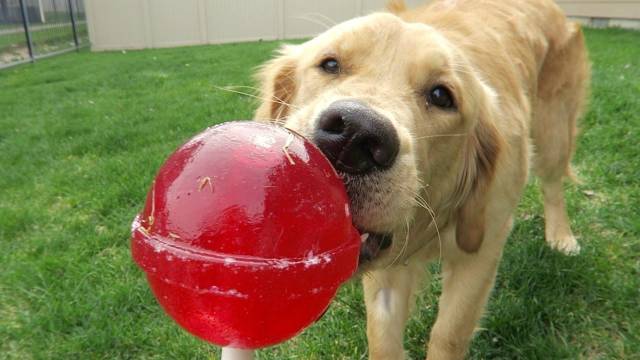Can Dogs Eat Suckers?
Can dogs eat suckers? Many of the questions we ask our dogs have the same answers. These sweet treats contain sugar, but are not fattening. Their main concern is a possible gastrointestinal blockage. As suckers are paper, the digestive fluids might not be able to break them down completely, leaving them only moist. A dog may show signs of abdominal pain and lethargy after eating suckers.
Sugar-free lollipops
While dogs can eat sugar-free lollipops, the artificial sweeteners used in these treats are harmful to their health. Dogs who eat too many lollipops can suffer from low blood sugar, or hypoglycemia, which can be life-threatening. In addition, xylitol, an artificial sweetener, is toxic to dogs, and even a small amount can kill them. To avoid such a situation, you should only give sugar-free lollipops to your dog. Sugar-free lollipops are not harmful to dogs, but they do contain xylitol, a highly toxic substance. Even the sugar-free variety may be toxic to dogs. Therefore, it is important to avoid giving your dog these treats. Sugar-free lollipops may be tempting to your pet, but you should always supervise them. If you are not sure about feeding your dog candy, it’s best to consult a vet.
Candy canes
While you might be tempted to let your dog have a treat every now and then, this is a bad idea. Even sugar-free candy canes contain high levels of sugar and can be toxic to dogs. This is especially true if your dog has diabetes. Also, even sugar-free candy canes contain harmful ingredients, such as corn syrup and food colors. Even peppermint candy canes aren’t good for dogs – peppermint extract can cause an allergic reaction in your pet. Although dogs rarely have cavities, the sugar content in candy canes can cause dental issues. When sugary treats are eaten, plaque builds up and bacteria can cause further damage. Your dog will be in discomfort and won’t want to eat, or even to drink water. In severe cases, your dog may not even be able to eat at all, and you’ll likely notice a marked change in his behavior.
Hard or gummy candies
Although dog foods may be marketed for dogs, these treats are toxic to canines. These treats also contain sugar substitutes, like sucralose, which has been tested extensively on dogs. Although it is not known whether sucralose will have any adverse effects on dogs, ingesting hard candies may obstruct the digestive tract. Furthermore, the wrappers of hard candies can become lodged in the throat or intestines of your pet, requiring surgery. Regular candy gummy bears are not toxic to dogs, but sugar-free varieties can be dangerous to your dog’s health. Sugar-free versions are even worse if they contain xylitol, a natural sugar substitute. As a general rule, keep all candy out of your dog’s reach. And supervise any children eating candy in the presence of a pet.
Lollipop sticks
Dogs can eat Lollipop sticks, but there are a few reasons to avoid giving them to your dog. Sugary treats, especially those made with artificial sweeteners, are bad for dogs’ health. Not only are these treats high in sugar, but many contain ingredients that are toxic to dogs. Other common ingredients that are harmful to dogs include raisins and theobromine. It’s best to avoid giving your dog lollipops altogether and distract him with something healthier. Dogs don’t need a lot of sugar, so they are often given these treats, but they still ingest the sugar in them. If you let your dog lick them, it may end up in the digestive system and can cause severe problems. If you suspect your pup has eaten a lollipop stick, you’ll want to take him to the vet right away. Your vet will be able to induce vomiting or pump his stomach. If this doesn’t work, surgery may be needed.
Red 40 dye
Red Dye 40 is an artificial food coloring that appears in many children’s products, including suckers and gummy bears. Children and adolescents consumed the highest average daily intakes of the red dye, with an average of 0.0045 milligrams of the coloring per pound of body weight. Adults, on the other hand, absorbed the lowest amount, consuming an average of 0.0014 milligrams per pound. Although Red Dye 40 does not cross the blood-brain barrier, researchers have shown that it dramatically alters brain activity. This effect was first noted by Dr. Benjamin Feingold, who suggested a link between red dye and hyperactivity. While his research was criticized as anecdotal, it nevertheless sparked years of research into the possible connection between red dye and hyperactivity. In fact, one study found that red dye was associated with a higher incidence of hyperactivity in children and young adults.
Caffeine
If you’re wondering, “Can dogs eat suckers with caffeine?” you’re not alone. Dogs can become highly intoxicated by caffeine. It can raise their blood pressure and cause cardiac arrhythmias. Caffeine also affects the gastrointestinal tract and can cause vomiting. A pet may also need to urinate more than usual after ingesting caffeine. The worst case scenario for a dog is to die from caffeine poisoning. Caffeine poisoning can be fatal in both cats and dogs. Even low doses of caffeine can be harmful to dogs. Caffeine, especially dark chocolate, can raise the blood pressure of dogs. And coffee-flavored candies can be deadly. Additionally, the sugar contained in the candies can cause upset stomachs and obesity. In fact, many sugar-free candies contain xylitol, which is highly toxic to dogs. Xylitol can cause low blood sugar levels and lead to liver failure, pancreatitis, and a range of other conditions.
